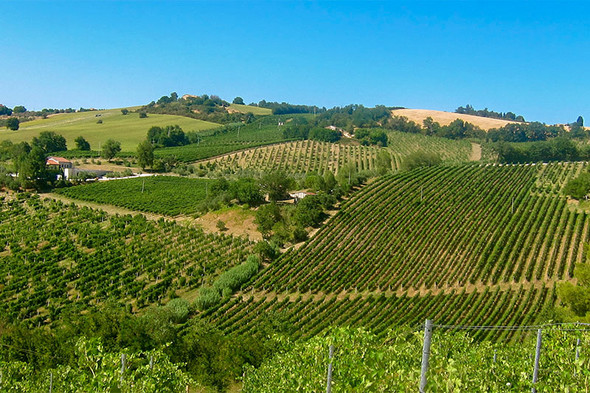Fine wine drinkers know Italy for its great reds. Names like Barolo, Barbaresco, Brunello and Amarone grace the wine cellars of many a wine connoisseur. Whereas Italy has never enjoyed great acclaim for its whites. In the past, oxidised and flat, now often considered a cheap quaffing wine, good as an aperitif or for pairing with seafood along the country’s vast coastline. This cheap and cheerful image is perpetuated by the floods of basic Prosecco, insipid Pinot Grigio and characterless Frascati and Soave that make it onto the shelves outside the country. Very few people realise that Italy boasts some white varieties that show great potential for ageing, one or two of which can be found in the Marche.
Unexplored territory in Central Italy
A recent trip to the Marche allowed me to explore this relatively undiscovered region, both from a tourist and wine perspective. The gently rolling green landscape punctuated with picturesque hilltop towns lodged between the Apennines and the Adriatic has kept itself relatively hidden from curious tourists who rather visit the green heart of Umbria to its west or the culinary powerhouse of Emilia-Romagna with its sweeping sandy beaches to the north. Wine lovers will be more familiar with its southern neighbour, Abruzzo, known for its full-bodied Montepulciano or the region it touches to the west, Tuscany, with its famous string of Sangiovese DOC(G)s. Yet, Marche also cultivates both these red varieties and produces delicious blends of the two in its key red DOC(G)s of Cònero DOCG and Piceno DOC. To my mind, the Montepulciano is far fresher and more elegant than that of its southern neighbour. However, the real treasure of Marche is two of its white varieties – Verdicchio and Pecorino, among Italy’s best. Here, we’ll take a look at Verdicchio, which some say can be reminiscent of Riesling as it ages, developing a flintiness and a hint of petrol.
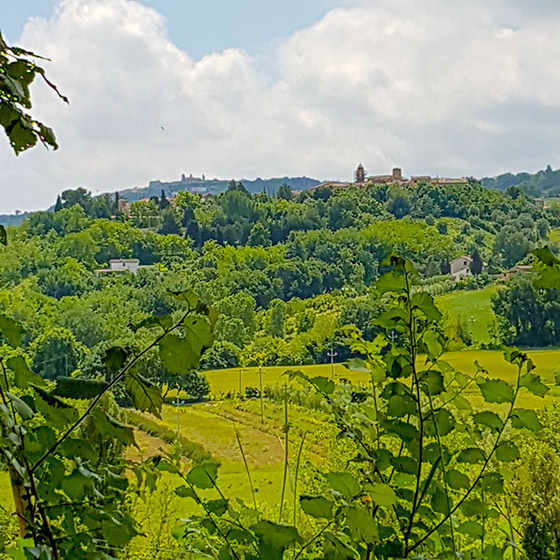
Bucci vineyards by Sue Tolson
Gone with the cheesy amphora bottle
Many of you may remember the curious amphora-shaped bottle representing Verdicchio on the supermarket shelves in the past. However, you probably didn’t find the wine all that memorable, yet Italian wine experts believe it to be one of the Italian whites with the greatest potential. Its name belies one characteristic of its grapes: coming from verde (green), the grapes remain green even when ripe and retain the high acidity so important for ageing. Thanks to this acidity, it can age for ten years or more and is one of the few Italian whites that responds well to oaking. The variety is used to produce all styles, from dry to sweet as well as sparkling, so is not only capable of ageing but is also versatile.
The amphora bottle is associated with the Verdicchio dei Castelli di Jesi DOCG, which produces light, generally somewhat floral wines. However, Marche also boasts a further DOCG for the cultivar, Verdicchio di Matelica DOCG, which is further inland, although higher, and cut off from the cooling sea breezes that Castelli di Jesi enjoys, thus its wines generally have higher acidity, but also more body and alcohol.
We visited numerous Verdicchio producers in Castelli di Jesi including Garofoli and Villa Bucci, both historic and revered producers of the variety, to see what the variety was capable of.
Modern Verdicchio pioneers
Carlo Garofoli, the winemaker and owner at Garofoli, now in his seventies, still makes all the wines at the winery and tells us about the winery’s philosophy, which is to make all wines 100% varietal to retain the character of the cultivar and to be able to taste the interaction between the terroir and the variety. He believes that typicity and terroir are some of the most important tools and tries to make different Verdicchio wines. Their Podium Verdicchio is the most awarded Verdicchio ever.
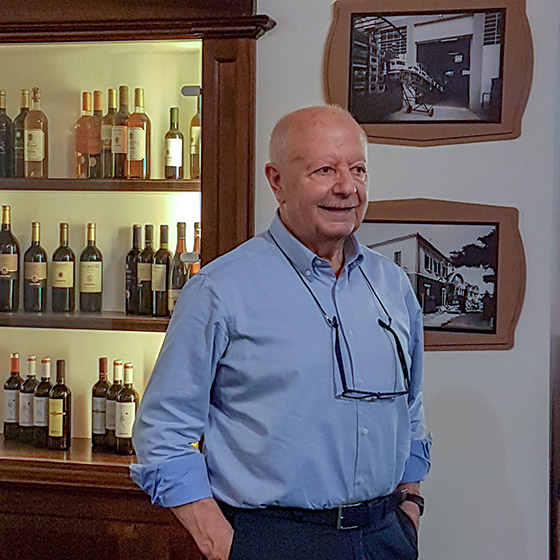
Carlo Garofoli by Sue Tolson
Garofoli were one of the first to eschew the amphora bottle for their Verdicchio. This bottle had become associated with mass-produced poor-quality wines exported in great quantities in the eighties. So, from 1981, they launched Macrina, their Verdicchio di Castelli di Jesi DOC Classico Superiore, one of the first not in the amphora bottle, in an attempt to change the perception of Verdicchio; the message was clear – it’s the wine inside the bottle that counts, not the packaging. It was seen as revolutionary. They then started to experiment with different versions and found similarities between Verdicchio and Chablis, so decided to make Verdicchio in the Chablis style. This gave rise to Serra Fiorese in 1990 which became Podium, a single-vineyard wine with 18 months ageing and now one of the most iconic Verdicchios in Castelli di Jesi. We tasted the current vintage, 2015, which showed beautiful rich, ripe fruit with spice and bitter almond along with steely acidity, mineral notes and a refreshing herbal streak. We then compared this to the 2008 vintage, according to Carlo, a very good year in the region, discovering a wine that still retained its green hues, but now gold with deeper green flecks with flavours of honey, dried fruit, apple, spice, salted almond, straw and dried tobacco leaf, along with still amazingly fresh acidity.
Carlo is also a lover of bubbles, so has also produced a Verdicchio-based traditional method sparkler since 1974, although his father had been producing charmat-method fizz since the fifties. In the beginning, he reveals, we had no way to freeze the neck when disgorging, so had to buy ice from the local fishmonger. We tasted the 2010 Brut Riserva, which had spent 78 months on the lees. A stunning wine with refreshing acidity, a fine mousse and structure along with flavours of yellow apple, brioche, honey and almond, still very fresh and fruity with lovely autolytic notes.
Remarkable liveliness even after nearly 30 years
Another opportunity to experience the remarkable ageworthiness of Verdicchio and its ability to reflect terroir was our visit to Villa Bucci, another of the classic Marche wineries. Five of their six vineyards are dedicated to Verdicchio and they boast numerous old vines, with many between 45 and 55 years old. They produce eight to ten different Verdicchios each year with each vineyard being vinified separately and then blended before bottling. We tasted four barrel samples and saw how each vineyard influenced the styles of wine produced by each. La Bora, the highest vineyard is cooled by sea breezes and gives fresh, salty wines with lemony notes, whereas the lower Montefiore’s wines are less salty. Like Garofoli, they also began taking Verdicchio seriously in the eighties when Verdicchio had no real style and was not easily recognisable, except by its kitsch bottle. Their flagship Villa Bucci is a regular recipient of awards and, needless to say, no amphora bottle in sight!
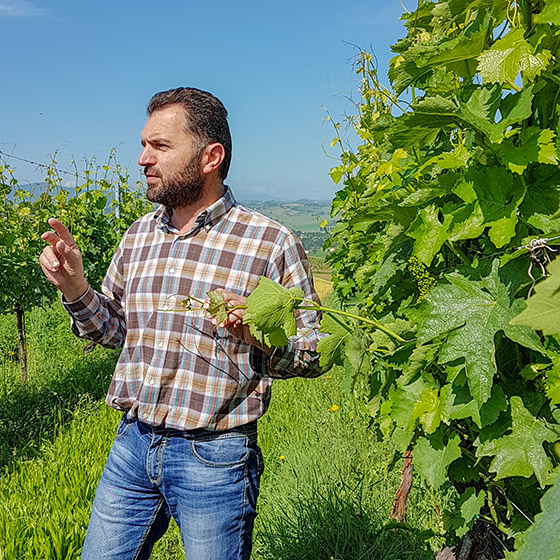
Bucci agronomist by Sue Tolson
Claudia Porta, niece of Ampelio Bucci, treated us to a mini vertical tasting of Villa Bucci Riserva from the 2015 (just hours before its official release) back to a 1992 magnum! The older vintages remained incredibly fresh and crisp thanks to their steely acidity and salinity, but also picked up beautiful honey, dried fruit, savoury and waxy notes while gaining in intensity and complexity. All the wines were characterised by a bitter almond note, which became increasingly like marzipan with age.
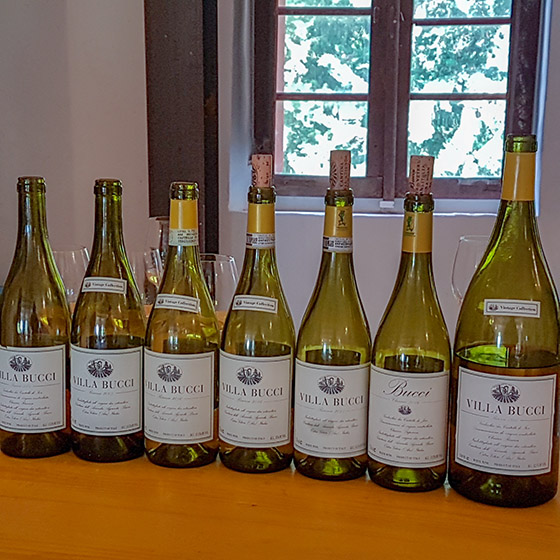
Bucci vertical by Sue Tolson
Mountain Verdicchio
Castelli di Jesi’s older yet smaller sibling, Matelica, pipping Jesi to the DOC post in 1967 (Castelli di Jesi 1968) and a mere tenth of its size, is also producing some stunning Verdicchios in its north-south valley inland from Jesi with a range of mountains blocking the cooling effects of the Adriatic. Teatro Piermarini in Matelica is now home to Verdicchio with the foyer and bar providing a tasting area for the region’s producers. Tasting through 22 wines from 12 producers with vintages ranging from 2017 to 2007, we also discovered lively, yet creamy, almond-scented fresh wines with hawthorn aromas that developed real character and complexity with age, sweet honey, spice, marzipan and notes of kerosene, while still maintaining incredible freshness and salinity. La Monacesca hosted our evening meal in their beautifully restored winery buildings, sacrificing a 1997 magnum of their Verdicchio for our pleasure, enabling us yet again to testify to Verdicchio’s great capacity for ageing.
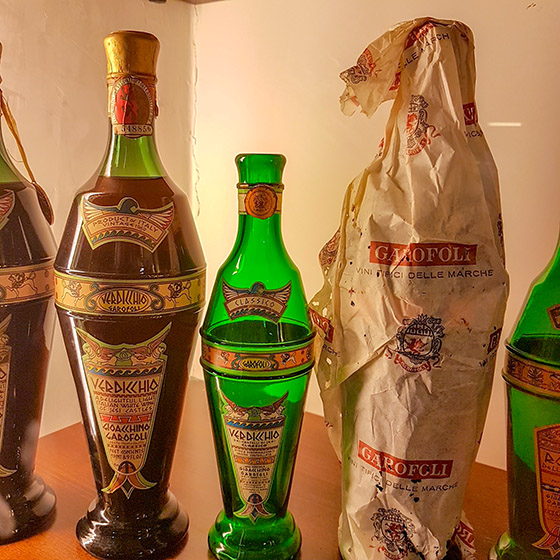
Old Verdicchio bottles by Sue Tolson
So, anyone who believes Italian whites should only be consumed young should seek out some older Bucci or Garofoli vintages, or try one of the less well-known wines, equally deserving of praise, from Matelica.
However, while you’re in the Marche, make sure you save time to stroll the streets of picturesque hilltop towns such as Torre di Palme, Petritoli, Matelica or Staffolo, peek into one of their unique municipal theatres and try one of the local specialities such as olive ascolani. Don’t forget to sip other hidden vinous curiosities such as aromatic red Lacrima di Morro d’Alba or sparkling red Vernaccia di Serrapetrona and explore other local whites like Passerina, Bianchello or the increasingly trendy Pecorino. Discover the Marche and its wines before everyone else does!



